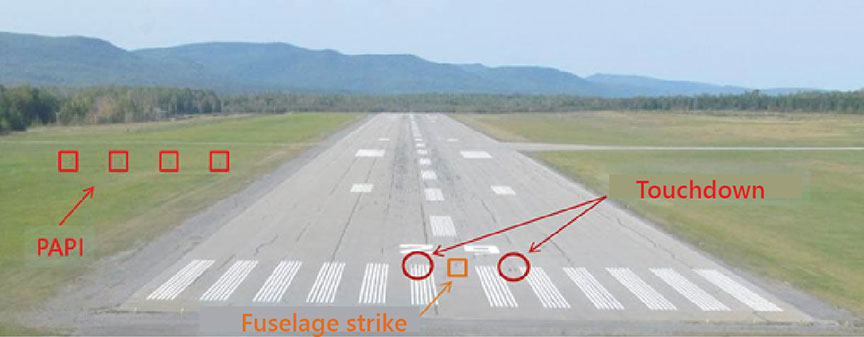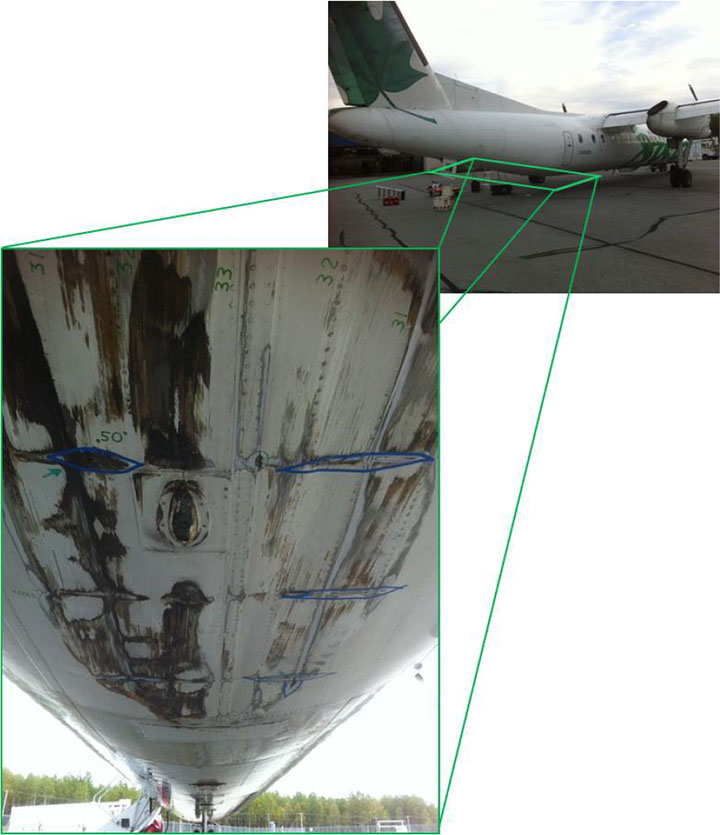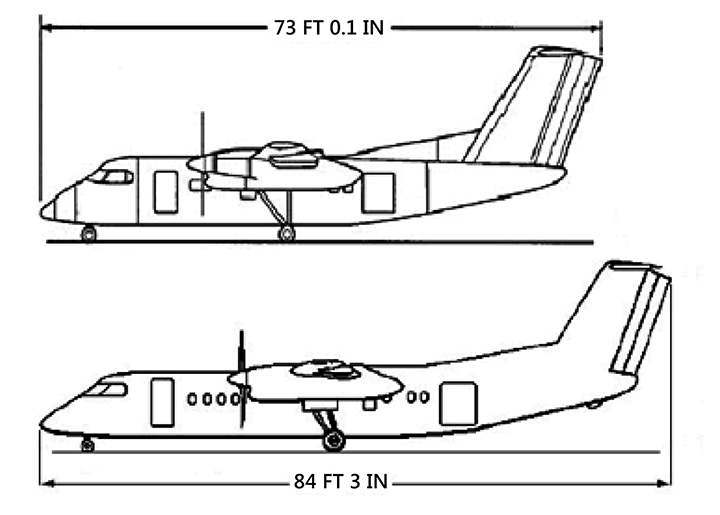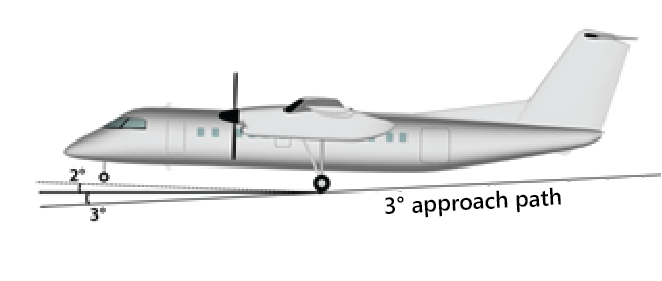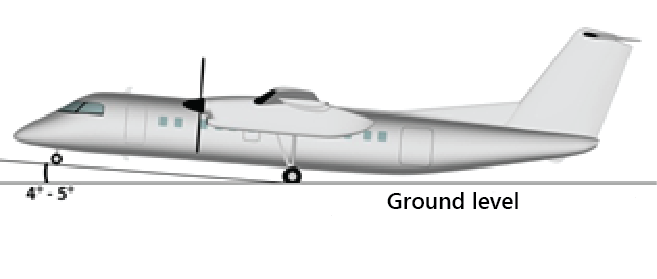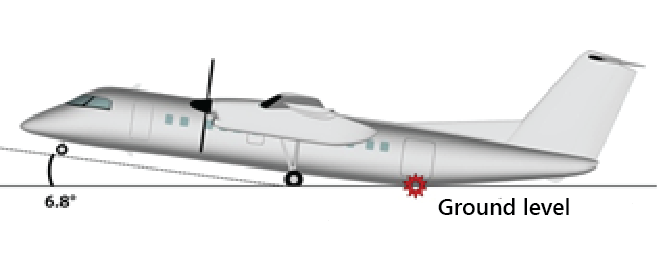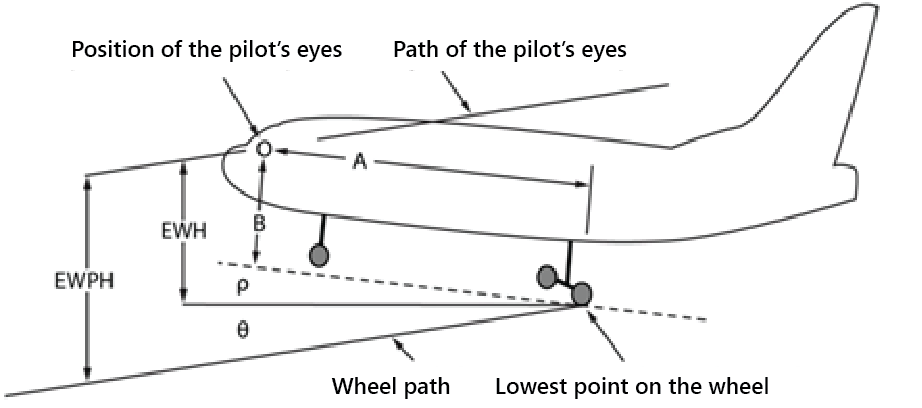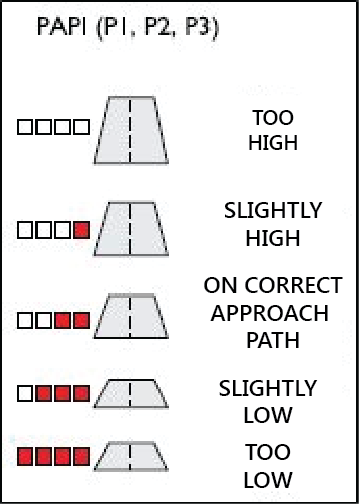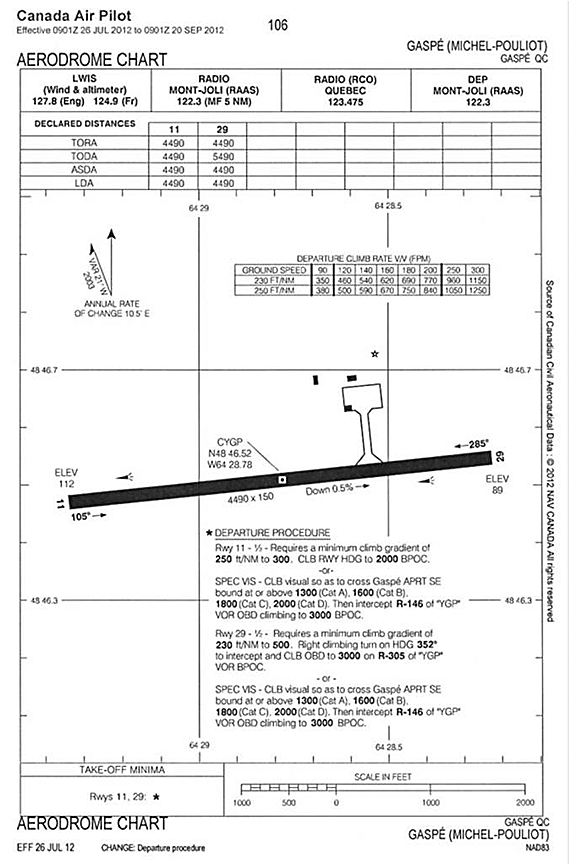Hard landing and aft fuselage strike
C-GUON DHC-8-301
Operated by Jazz Aviation LP
Gaspé Airport, Quebec
The Transportation Safety Board of Canada (TSB) investigated this occurrence for the purpose of advancing transportation safety. It is not the function of the Board to assign fault or determine civil or criminal liability. This report is not created for use in the context of legal, disciplinary or other proceedings. See Ownership and use of content. Masculine pronouns and position titles may be used to signify all genders to comply with the Canadian Transportation Accident Investigation and Safety Board Act (S.C. 1989, c. 3).
Summary
The DHC-8-301 (registration C-GUON, serial number 143), operated by Jazz Aviation LP as JZA 8721, was flying from Îles-de-la-Madeleine Airport (CYGR), Quebec, to Gaspé Airport (CYGP), Quebec, with 32 passengers and 3 crew members. At 1412, Eastern Daylight Time, the aircraft made a hard landing, and the aft fuselage struck the runway. After the landing, the aircraft taxied normally to the air terminal, and the passengers disembarked. No one was hurt, but as a precaution, 8 passengers went to the hospital to be examined. All returned to the airport to take a flight aboard a replacement aircraft, as C-GUON had sustained significant damage. The emergency locator transmitter did not activate during this occurrence.
1.0 Factual information
1.1 History of the flight
Flight JZA 8721, a DHC-8-301 (DH8C) (registration C-GUON, serial number 143) operated by Jazz Aviation LP, was destined for Gaspé Airport (CYGP), Quebec, from Îles-de-la-Madeleine Airport (CYGR), Quebec. It was the first of 4 flights planned on that day for the crew, who were already in les Îles-de-la-Madeleine. At 1427,Footnote 1 the aircraft left CYGR with 32 passengers and 3 crew members. The co-pilot was the pilot flying (PF), and the pilot-in-command was the pilot monitoring (PM).
Cruising at 14 000 feet above sea level (asl), the crew received clearance from air traffic control to perform a contact approachFootnote 2 on Runway 29 at CYGP. At 1403,Footnote 3 the PF began the descent and headed directly toward the OVUBI final approach fix, located 5.5 nautical miles (nm) from the threshold of Runway 29.
At 1410, the aircraft intercepted the final approach 5 nm from the runway, at a height above touchdown (HAT) zone elevation of about 2400 feet and a speed of 138 knots. The aircraft reached the optimum descent angle of 3° from above and continued its approach, descending gradually below the slope indicated by the precision approach path indicator (PAPI). At approximately 170 feet HAT, when the aircraft descended below the lower limit of the PAPI range (with 4 red lights visible),Footnote 4 the PF reduced power; the rate of descent increased, and the aircraft was aiming for the runway threshold. At about 45 feet HAT, when the aircraft was 700 feet from the runway threshold, power was reduced to idle, and speed dropped to VREFFootnote 5 +3 in deceleration.
At 1412, the aircraft made a hard landing, during which the lower part of the aft fuselage came into contact with the runway and the “Touched Runway” indicator came on. Footnote 6 The first wheel marks of the right main gear appeared at 109 feet from the threshold of Runway 29 (Photo 1). After landing, the aircraft backtracked normally on the runway, taxied, and parked in front of the air terminal at 1416.
The crew members inspected the exterior of the aircraft and contacted the maintenance department with their observations of the damage. As a precaution, passengers who felt pain at the moment of impact were asked whether they would like to be examined at the hospital. Eight passengers were examined, and all returned to board a later flight with a different aircraft.
1.2 Deaths and injuries
None.
1.3 Damage to the aircraft
The examination of the aircraft revealed traces of the impact and scuff marks on the skin, structural stiffeners and longerons of the lower portion of the fuselage (Photo 2). Depressions and deformations of the skin were observed on the lateral surfaces of the fuselage under the wings and under the tail unit.
The inspection after the hard landing was performed according to instructions in the aircraft maintenance manual (AMM)Footnote 7 for the DH8C. Temporary repairs were made before the ferry flight to the manufacturer's repair centre at the Montréal–Mirabel Airport, Quebec. The permanent structural repairs were completed, and the aircraft was returned to service.
1.4 Other damage
Not applicable
1.5 Crew information
| Pilot-in-command | Co-pilot | |
|---|---|---|
| Licence | Airline transport pilot licence (ATPL) | ATPL |
| Medical expiry date | 01 October 2012 | 01 November 2012 |
| Total flying hours | 11 700 | 4500 |
| Hours, last 90 days | 139 | 122 |
| Hours on type, last 90 days | 139 | 122 |
| Hours off duty before work period | 13 | 13 |
The flight crew was licensed and qualified for the flight in accordance with existing regulations.
The pilot-in-command held a valid airline transport pilot's licence, issued in August 1991, and had about 11 700 hours of flight time, including 6600 hours on the various Dash 8 models, with some 6000 hours as pilot-in-command. The pilot-in-command had worked for the company since September 1995. The pilot's approved semi-annual recurrent training to replace the pilot proficiency check (PPC) took place in March 2012.
The co-pilot held a valid airline transport pilot's licence, issued in February 2008, and had approximately 4500 total hours of flight time, some 700 hours of which were on Dash 8 models. The co-pilot had worked for the company since March 2011 and passed a PPC on the DH8C in July 2012.
Before the start of this 3-day assignment, the pilot-in-command had been off duty for 2 days, and the co-pilot had worked on the previous 3 days. On the first day of this assignment, the 2 pilots made a series of 5 flights, which ended at CYGR at approximately 2300. The next day, the crew reported to the airport at 1350 for the occurrence flight. The crew had a rest period in compliance with the provisions of the Canadian Aviation Regulations (CARs). There is no indication that the crew were fatigued at the beginning of their workday, either due to lack of sleep or any health problem.
1.6 Aircraft information
1.61 General
C-GUON is a DH8C, which is a stretch version of the DHC-8-100 (DH8A) with an additional 11.3 feet, increasing the maximum passenger capacity from 36 to 50 (Figure 1).
The propellers are 13 feet in diameter. As with other aircraft with wing-mounted engines, when power is increased, lift is increased by airflow over 26 feet of wing; and when power is reduced to the minimum, the propellers impede the airflow, and therefore the lift, over 26 feet of wing.
The aircraft took off from CYGR with a weight of 38 350 pounds and landed at CYGP with an estimated weight of 37 230 pounds. The aircraft's weight and balance were within the manufacturer's specified limits.
| Manufacturer | De Havilland (Bombardier) |
|---|---|
| Type and model | DHC-8-301 |
| Year of manufacture | 1989 |
| Serial number | 143 |
| Certificate of airworthiness | Valid |
| Total airframe time | 50 880 |
| Number of airframe cycles | 58 725 |
| Engines | 2, turboprop (PW123) |
| Maximum allowable take-off weight | 41 100 lb (18 643 kg) |
| Maximum allowable landing weight | 40 000 lb (18 144 kg) |
| Recommended fuel type | Jet A, Jet A-1, JP5, JP8, Jet B, JP-4 |
| Fuel type used | Jet A-1 |
1.6.2 Maintenance
Maintenance on C-GUON was carried out by the approved maintenance organization (AMO) of Jazz Aviation LP (no. 21-92), following a maintenance schedule approved by Transport Canada (TC). According to the company's records, C-GUON was certified, equipped, and maintained by the company in accordance with existing regulationsFootnote 8 and with the AMO's procedures. An examination of the aircraft's technical documents showed that the applicable airworthiness directives were carried out in compliance with the maintenance program.
No technical defects were identified on the aircraft before the occurrence, and the aircraft showed no anomalies. Nothing suggested that a failure of the airframe or a system malfunction had occurred during the flight.
1.6.3 Emergency locator transmitter
C-GUON was equipped with an emergency locator transmitter (ELT) that can broadcast on frequencies 121.5, 243 and 406 megahertz. The ELT and the antenna, installed along the longitudinal axis in the dorsal fin of the aircraft, were not damaged. The ELT was not activated during this event, as the impact was primarily along the vertical axis.
1.6.4 Terrain awareness and warning system
The aircraft was equipped with a terrain awareness and warning system (TAWS). The system warns of potentially unsafe terrain closure rates and provides calls at 50, 40, 30, 20, and 10 feet above ground level (agl). C-GUON's TAWS was sent to the Transportation Safety Board (TSB) Laboratory for its memory to be downloaded and for determination of whether alarms were generated during the flight. There was no event log in the memory, so no information about the occurrence flight was available. The loss of the event log was related to the software version used, but the ability of the system to produce alerts in flight was not impeded. The log storage problem was resolved in a later version of the software.
1.6.5 Geometry of the DH8C during approach and landing
The attitude of the DH8C is between 2° and 3° nose-up on a 3° final approach path, in landing configuration with flaps at 15° and at VREF +5 knots (Figure 2). Normally, the attitude is increased approximately 2° during the flare for landing, and the aircraft sets down with a nose-up attitude of between 4° and 5° (Figure 3).
When the main gear oleos are extended, the tailskid makes contact with the runway when the nose-up attitude reaches an angle of 11.9° (Figure 4). However, when the main gear oleos are completely compressed, for example, during a hard landing, the lower part of the fuselage strikes the runway at an angle of 6.8° nose-up (Figure 5). Data on the angle of impact of the fuselage are not published in the DH8C aircraft operating manual (AOM).
According to information collected, 16 cases of fuselage strike involving the DH8C occurred worldwide between 1992 and 2012, including 2 in Canada involving Jazz Aviation LP. In response to fuselage strikes around the world, the manufacturer developed a training videoFootnote 9 in 2003 about the importance of controlling the nose-up attitude when landing the DH8C and the DH8D. Although the DH8D is about 23 feet longer than the DH8C, when the gear oleos are compressed during a hard landing, both aircraft will sustain impact to the fuselage at approximately 7° nose up.
The video also highlights the importance of monitoring the nose-up attitude and controlling an excessive rate of descent by increasing power rather than increasing the nose-up attitude near the ground.
At the time of the occurrence, the company's DH8C pilots had not seen this video. The AOM did not contain details on this manufacturer-recommended technique, and pilots received no particular training in this regard.
According to the company's maintenance management system (Trax), during the period between 01 January 2002 and 31 December 2012, 1 fuselage strike involving the DH8A and 2 fuselage strikes involving the DH8C occurred.
In 2011, Jazz Aviation LP's various Dash 8 models recorded a total of 161 659 flights, with an average of 443 flights per day. None of the pilots interviewed during this investigation had to take over the controls of a Dash 8 on landing while in the role of PM.
1.6.6 Eye-to-wheel height and eye-to-wheel path height
The eye-to-wheel height (EWH) is the vertical distance between the pilot's eyes and the lowest part of the aircraft in landing position (Figure 6). This height varies from under 4 feet up to 45 feet for certain wide-body aircraft like the Boeing 747.
The TSB Laboratory calculated the EWH of the DH8C to be 10.4 feet. However, at the moment when the pilot's eyes cross the runway threshold, the wheels have not yet reached the threshold, so the pilot has to take into account the horizontal and vertical distance that must be travelled by the wheels to reach the threshold. This vertical height between the pilot's eyes and the wheel path (eye-to-wheel path height, or EWPH) is 11.9 feet for the DH8C. The EWPH is used to determine the height of the wheels at the moment they cross the runway threshold. Some documents use the EWH and the EWPH interchangeably, and yet the difference is 1.5 feet for the DH8C. This report uses the EWPH, as it indicates more accurately the height of the wheels as they cross the threshold than the EWH, which is independent of path. EWH and EWPH data are not published by the manufacturer and do not appear in the DH8C's AOM.
The pilot must know the aircraft's EWPH to be aware of the distance of the wheels under its path (particularly during a visual approach) and thus to understand the impact of a deviation below the normal 3° approach path.
TSB Aviation Investigation Report A07A0134 identified gaps in pilot knowledge of the EWH and the difficulty in finding this data, and the Board issued a recommendation that:
The Department of Transport ensures that eye-to-wheel height information is readily available to pilots of aircraft exceeding 12 500 pounds.
TSB Recommendation A09-03
The intent of the recommendation was for TC to require manufacturers to publish EWH information in approved aircraft documents used by crew members.
In response to the recommendation, TC published information addressing visual approach slope indicators and the EWH. In addition, Canadian manufacturers were notified of the existence of this information and of the possibility that operators may contact them to obtain the EWH of aircraft. In its assessment of 06 March 2013, the Board noted that the measures taken by TC, while commendable, did not achieve the intent of Recommendation A09-03. TC's response is considered Satisfactory in Part. Because TC indicated that no other measures were planned, the risk associated with this recommendation remains.
1.7 Weather conditions
The 1400 aviation routine weather report (METAR) for CYGP recorded the weather conditions as surface winds of 350° true (T) at 11 knots and a surface visibility of 15 statute miles (sm), with few clouds at 4000 feet agl and a cloud ceiling of 18 000 feet agl. The temperature was 19°C, with a dew point of 8°C and an altimeter setting of 29.72 inches of mercury.
The aerodrome forecast (TAF) for CYGP, issued at 0941 and valid from 1000 until 2000, predicted winds 320° T at 8 knots, with a visibility of more than 6 sm and a cloud ceiling of 6000 feet agl.
The approach and landing occurred in visual meteorological conditions. The weather and wind gradient from 6000 feet to the surface at CYGP at the time of the occurrence were not favourable for downdraft conditions related to mountain wave or wind shear.
1.8 Navigation aids
Not applicable.
1.9 Telecommunications
CYGP is an uncontrolled airport located in Class E airspace with a mandatory frequency (MF) area of 5 nm around the airport, up to an altitude of 3100 feet asl. The Mont-Joli flight service station (FSS) provides information with respect to arrival, departure, and in-transit phases in the MF area.
1.10 Aerodrome information
1.10.1 General
CYGP has an asphalt runway (Runway 11/29), which is 4490 feet long and 150 feet wide (Appendix B). The touchdown zone elevation (TDZE)Footnote 10 of Runway 29 is 98 feet asl; however, the exact elevation of the threshold of Runway 29 is 89 feet asl.
The airport has a type KFootnote 11 aircraft radio control of aerodrome lighting (ARCAL) system, which activates the entire aerodrome lighting system, including the PAPI. Runway 29 has ADFootnote 12 approach lighting, runway threshold lights, 3-way medium-intensity runway edge lights, and a category P2 PAPI, which is suited to aircraft with an EWH of less than 25 feet. A visual inspection is performed daily, while a full inspection, including verification of the angle of the PAPI, is done every 3 months. The last complete inspection took place on 17 June 2012.
The PAPI (P2) at CYGP is installed 730 feet from the threshold of Runway 29, and is adjusted to indicate a slope of 3°. This installation provides an “on-slope” indication where the eye crosses the runway threshold at a height of 38 feet agl. Because the EWPH of C-GUON approaching on-slope is 11.9 feet, the wheels cross the runway threshold at a height of approximately 26 feet agl.
1.10.2 Approach slope indicators
An approach slope indicator is a lighting system visible from at least 4 nm and arranged to provide a visual indication of the desired approach slope toward a runway (generally 3°). An aircraft that follows the on-slope indication at a certified airport will be provided with safe obstruction clearance to a minimum of 6° on either side of the extended runway centreline, out to 4 nm from the runway threshold.Footnote 13
The approach slope indicators, or visual glideslope indicators (VGSIs), comprise different types of systems, including the PAPI (precision approach path indicator).
The PAPI consists of 4 lights located on the left-hand side of the runway in the form of a wing bar (Figure 7). Through adjustment of the distance of the lighting units from the threshold, adequate clearance is assured for aircraft with different EWHs. The threshold crossing height (TCH) increases proportionally with the distance of the PAPI from the threshold (Figure 8).
PAPIs are grouped according to the EWH of aircraft configured for approach, as follows:
- APAPI (AP): Abbreviated PAPI for aircraft with an EWH of up to 10 feet;
- PAPI (P1): For aircraft with an EWH of up to 10 feet;
- PAPI (P2): For aircraft with a EWH of up to 25 feet;
- PAPI (P3): For aircraft with a EWH of up to 45 feet.
According to these criteria, a PAPI (P2) is required to ensure adequate TCH for the DH8C.
Most PAPIs at airports and aerodromes used by the DH8C are P2 Category. However, there are a few exceptions, such as Rimouski, Quebec, and Roberval, Quebec, which have a PAPI (P1), and Bathurst, New Brunswick, which has an APAPI (AP).
It is important to note that PAPIs P1, P2, and P3, when on approach and in the cockpit, are absolutely identical from the pilot's perspective. To determine the type of PAPI installed, the pilot has to check the available aerodrome information.
The pilots interviewed as part of this investigation were not familiar with the limits of the PAPIs installed and used at aerodromes served by the DH8C. The pilots know that there are different types of PAPIs, but generally speaking, they are unaware of the limits that determine the category of PAPI.
TSB Aviation Investigation Report A07A0134 identified that, overall, pilots are unfamiliar with the different types of VGSIs (including the PAPI) and their limits. Consequently, as long as pilots do not have a thorough understanding of the different types of VGSIs in use and the importance of VGSI limits with regard to safety, they may continue to follow visual guidance that is not necessarily suited to the aircraft they are flying. In this same report, released in 2009, TSB issued a recommendation that:
The Department of Transport require training on visual glide slope indicator (VGSI) systems so pilots can determine if the system in use is appropriate for their aircraft.
TSB Recommendation A09-04
Since 2007, TC has published a number of documents on VGSIs and, in 2013, it maintained that pilots receive training as part of their private, commercial, and night-flying courses. However, TC did not demonstrate to the TSB that this training is given when pilots are trained on larger aircraft, with a higher EWH and, therefore, with a more critical threshold clearance.
In its assessment of 06 March 2013, the Board was encouraged that the information on VGSIs had been diffused in a number of locations. However, the Board remains concerned that TC has not taken measures to ensure (for instance, during pilot proficiency checks) that pilots can determine whether the VGSIs that they are using are appropriate for their aircraft. The response by TC is considered Satisfactory in Part. TC indicated that it is not considering any further action at this time, and as a result, the risk associated with this recommendation remains.
1.11 Flight recorders
1.11.1 Flight data recorder
C-GUON was equipped with a flight data recorder (FDR). The FDR was sent to the TSB Laboratory for extraction and examination of recorded data.
1.11.2 Cockpit voice recorder
The aircraft was equipped with a cockpit voice recorder (CVR) with a rated recording time of 30 minutes. The CVR complied with the requirements of the CARs. The recording began at 1453:41 and ended at 1524:31, which was 1 hour and 8 minutes after the end of the flight. Consequently, the conversations and sounds in the cockpit during approach and landing were overwritten.
The Transportation Safety Board Regulations in effect at the time of the accidentFootnote 14 were clear that the owner, the operator, and the crew must preserve and protect any evidence relevant to the accident.
In 2009, following an in-flight electrical emergency involving a DH8C operated by the same company, the CVR recordings were overwritten, because the aircraft was not quarantined once it was parked.Footnote 15 The company implemented measures to ensure that CVR data would be preserved. However, the CVR recordings were not preserved in the present occurrence, as the crew did not realize that this event was a reportable occurrence until the damage level to the aircraft was determined.
1.11.3 Image (video) recording
Following the TSB investigation into the accident involving Swissair Flight 111 in Nova Scotia in 1998, the Board issued a recommendation about the recording of images in the cockpit.Footnote 16 Transport Canada does not intend to take any action related to the recording of images in the cockpit.
Because C-GUON was not equipped with an image (video) recording device, critical information was not available that would have helped investigators reconstruct with greater accuracy the sequence of events leading up to the accident.
1.12 Wreckage and impact information
The first wheel marks from the main gear appeared 109 feet from the runway threshold, followed by contact marks from the left main gear and, finally, from the fuselage 114 feet from the runway threshold. All marks were aligned with the centre of Runway 29. The TSB Laboratory used a 3 dimensional computer-assisted design model of the DH8C to align the aircraft with the marks on the runway and establish the aircraft's nose-up attitude at about 7° with the main gear oleos compressed by the hard landing.
1.13 Medical and pathological information
The investigation revealed no medical or pathological factors that could have affected the performance of the crew's duties.
1.14 Fire
None.
1.15 Survival aspects
Not applicable.
1.16 Tests and research
1.16.1 Approach path
The TSB Laboratory created a number of FDR plots, including several for the approach and landing (Appendix C). For the purpose of comparison, the previous 6 approaches and landings were plotted and juxtaposed with those of the approach and landing of the occurrence flight.
Because the global positioning system (GPS) location is not recorded by the model of FDR used by the occurrence aircraft, the TSB Laboratory calculated the ground speed to establish the aircraft's glideslope from the known point of impact.Footnote 17 This slope was then compared with the PAPI glideslope.
Radio altimeter data were not recorded and, as a result, the path could not be established with precision under 40 feet agl because of the ground effect on the barometric altimeter reading.
The TSB Laboratory added the five PAPI indicationsFootnote 18 to the plotted flight paths in order to create a visualization of the aircraft's path compared with the optimum approach slope of 3° at the middle of the PAPI indications (Appendix C).
Once on final approach, the aircraft reached the upper limit of the PAPI indication (4 white lights) at approximately 3.5 nm from the runway threshold, at 1300 feet HAT and a speed of 130 knots. Appendix C shows that, at about 1.5 nm from the runway threshold, at 500 feet HAT, the aircraft was on the optimum slope and its speed was 119 knots (VREF +16).
The aircraft gradually descended below the optimum slope to reach the lower limit of the PAPI indication (4 red lights) 0.5 nm from the runway threshold, at 170 feet HAT and a speed of 115 knots (VREF +12). At this point, the aircraft's power was reduced from 15% to 9%, its speed dropped, its rate of descent increased slightly, and it descended on a slope of approximately 3.8°.
The reduction in power to idle began 4 seconds, or approximately 700 feet, before reaching the runway threshold; the aircraft was at about 45 feet HAT, and the speed was 106 knots (VREF +3). The nose-up attitude dropped very slightly, and the rate of descent suddenly increased.
When the aircraft crossed the runway threshold, its speed was 100 knots (VREF −3) and dropping, and the nose-up attitude increased quickly at a rate of 5° per second. The aircraft made a hard landing at a speed of 98 knots (VREF −5). The lower portion of the fuselage hit the runway 0.03 seconds after the wheels first touched down, when the nose-up attitude reached 7° and the force of deceleration exceeded 3.4 g.Footnote 19
1.16.2 Descent below the optimum approach slope of 3°
Descent below the optimum glideslope of 3° is generally not recommended. TSB has previously pointed out this safety deficiency in TSB Aviation Investigation Report A07A0134, which discussed the circumstances surrounding an accident in which the aircraft landed before the runway using an aiming point near the runway threshold. However, standard operating procedures for some operators accept or encourage this practice under certain circumstances when there is a short-field landing.
In 2011, an aircraft operated by Jazz Aviation LP landed short of the runway at Montreal–Pierre Elliott Trudeau International Airport.Footnote 20 The approach was below the slope to perform a short-field landing and exit on taxiway A4; the aircraft touched down about 40 feet before the threshold of Runway 06 Right. The left wheel of the left main gear hit a light on the runway threshold. The aircraft did not sustain damage other than a gash on a tire.
1.16.3 Stabilized approach and energy management
Following the recommendations of its Approach-and-Landing Accident Reduction (ALAR) Task Force, the Flight Safety Foundation (FSF) created and distributed an ALAR tool kit, which was intended to reduce the number of approach and landing accidents (ALAs).
The FSF toolkit defines a stabilized approach, including the minimum altitude at which an approach should be stabilized, as well as all of the elements of a stabilized approach.Footnote 21 One of the recognized elements is an aircraft speed of between VREF and VREF +20 knots. Specific limits on excessive deviation for approach elements, along with a stabilization altitude limit, provide pilots (PF and PM) with a shared reference point, thereby reducing the possibility of ambiguity. In such a context, deviations are detected more quickly, and calls are faster and more accurate.
According to the task force, unstabilized approaches were a causal factor in 66% of ALAs and serious incidents around the world between 1984 and 1997. They were related to improper energy management and, in 36% of cases, they occurred when the aircraft was slow, low, or a combination of both, during the approach.Footnote 22
Further research in 2013 indicated that about 3–4% of all approaches are unstable, and 97% of these are continued to a landing.Footnote 23 The TSB has identified the need to reduce the incidence of unstable approaches that are continued to a landing in its investigation (A11H0002) into the accident involving FAB 6560 in Resolute Bay. The Board recommended that:
Transport Canada require CARs Subpart 705 operators to monitor and reduce the incidence of unstable approaches that continue to a landing.
TSB Recommendation A14-01
The FSF reiterated in its briefing note on energy managementFootnote 24 that the inability of a crew to assess or manage the energy condition of an aircraft during approach is often cited as the cause of unstabilized approaches. An energy deficit (or even an energy surplus) can result in an ALA or a related incident, loss of control, landing short of the runway, a hard landing, a fuselage strike, or a runway overrun.
The energy condition of an aircraft is evaluated based on the following flight parameters:
- airspeed and airspeed trend;
- altitude (or the vertical speed, or the flight path angle);
- drag (caused by speed brakes, flaps, and landing gear); and
- thrust.Footnote 25
One of the crew's main duties is to monitor and control the aircraft's energy condition using available reference points to maintain an energy condition appropriate to the phase of the flight and correct low or high energy situations. This energy control involves a balance between speed, power, drag and flight path.
The approach speed is ordinarily slightly behind the minimum approach power curve, and consequently speed is unstable in deceleration.Footnote 26 A reduction in speed requires an increase in power to maintain the path; as a result, the deceleration trend increases if power is not increased.
1.17 Organizational and management information
Jazz Aviation LP holds a valid air operator certificate. At the time of the occurrence, the company was operating a fleet of 130 aircraft, including 79 different DH8A, DH8C, and DH8D models of aircraft. These aircraft are operated according to CARs Subpart 705, Part VII (Airline Operations). The company has had a TC-approved safety management system (SMS) since June 2009. According to the company's SMS manual (the Jazz Corporate Safety and Quality Manual), aspects of the SMS are delegated to and managed by an independent departmentFootnote 27 to achieve a coordinated, integrated approach to safety for the entire company.
According to the company operations manual (COM), flight data and cockpit voice data recorders must be preserved and protected.Footnote 28 In addition, when an incident or an event occurs during a flight, the CVR circuit breaker can only be pulled after the arrival at the gate.Footnote 29 However, there is nothing indicating that it must be deactivated immediately after the flight.
1.17.1 Standard operating procedures
The company's DH8A and DH8C aircraft standard operating procedures (SOPs) are published in the Jazz DASH 8 AOM Volume 2: Aircraft Operating Manual: Revision 5b. The SOPs incorporate standardized calls that must be made by crews to coordinate the duties of the PF and the PM and to identify any deviations from the standard.
Call-outs are required during the approach:
- when there is excessive deviation from the approach profile;
- when the rate of descent exceeds 1000 feet per minute;
- when the speed is greater than 10 knots above or 0 knots below the target speed; and
- when the aircraft's nose-up attitude exceeds 6°.
There were no deviation call-outs during the approach and landing at CYGP.
According to the stabilized approach factors, in normal conditions, the aircraft must be stabilized at 1000 feet above field elevation (height above airport [HAA]) during an approach in instrument meteorological conditions and 500 feet HAA in visual meteorological conditions. To be considered stable, the aircraft must be in landing configuration and have:
- a stable rate of descent (500–800 feet per minute);
- a constant profile;
- an appropriate airspeed (VREF +5); and
- the required engine power (to maintain speed).
According to the SOPs, if a fuselage strike occurs (upon which the “Touched Runway” light is illuminated), the pilot-in-command must immediately advise air traffic control (ATC) and dispatch. ATC was not advised that a fuselage strike had occurred.
1.17.2 Visual approach and normal landing
During the approach to CYGP, the estimated landing weight of C-GUON was 37 230 pounds, and the VREF was 103 knots. The target airspeed on final approach was 120 knots with the gear down and the flaps at 15°. Eventually, the speed would have had to be reduced for the aircraft to be stabilized at 108 knots (VREF +5), with the gear down and flaps at 15°, before 500 feet HAA (i.e., the minimum altitude for achieving stabilization).
1.17.3 Short-field landing
To perform a short-field landing, the SOPs recommend having the gear down with flaps at 35° and maintaining a descent path appropriate to a speed of VREF +5. At the end of the approach, the speed is reduced to cross the runway threshold at the VREF, at a height of 30 feet agl, while aiming for a wheel touchdown in the first 500 feet of the runway.
1.17.4 Go-around procedure
According to the SOPs, not achieving or maintaining a stabilized state is one reason for a missed approach. According to the COM,Footnote 30 one of the reasons that a flight crew shall initiate a go-around procedure is “if the aircraft is not stabilized at or after descending below the minimum height for stabilization as defined in the aircraft specific operating procedures. That height shall not be less than 500 feet AGL.”
1.18 Additional information
1.18.1 Decision making in a changing environment
Pilots make decisions in changing conditions, under which the information available reflects the dynamic environment in which the aircraft is flying. A number of models have been developed to explain the decision-making process of pilots in these dynamic environments. Essentially, these models are based on similar principles, according to which the decision-making process is a loop made up of 3 sequential steps: situational awareness,Footnote 31 decision making, and observation of performance resulting from the decision.
The crew must be aware of the actual situation to make an appropriate decision. In a cockpit, cross-checks and effective communication between flight crew members mitigate errors of perception.
Situational awareness is the result of 3 steps:Footnote 32 perception of the elements in an actual situation, understanding of the situation, and projection of the situation in time. Pilots' training, knowledge, experience, and preconceptions are some of the individual factors that influence their understanding of a situation.
Mental workload is a factor that influences the decision-making process, and it can be defined as the quantity of information to be analyzed at a given moment. Mental workload increases as a function of the quantity and complexity of the information received. When abnormal or urgent situations arise, pilots must analyze complex and possibly conflicting information to gain an accurate understanding of the situation, which is essential to implementing an appropriate plan. Information overload can contribute to an incorrect interpretation of the situation.
When information overload occurs, pilots often concentrate on a portion of the information to the detriment of the entire situation. This funneling of information is beneficial only if the pilots have chosen the right information.
According to the FSF, a stabilized approach on the optimum slope is known to reduce workload and increase the crew's understanding of their situation by providing more time to monitor the path, rate of descent, and speed trends, and therefore the aircraft's energy status.Footnote 33
1.19 Useful or effective investigation techniques
Not applicable.
2.0 Analysis
2.1 General
The approach and landing occurred in visual meteorological conditions, and there is no indication that they were a factor in this occurrence. All of the aircraft's systems were operating normally. The crew was qualified, and there is no indication that fatigue played a role in the occurrence. As a result, the analysis will concentrate on the crew's actions and on the procedures used during the approach and landing.
C-GUON's cockpit voice recorder (CVR) has a rated recording time of 30 minutes and was deactivated 1 hour and 8 minutes after the aircraft's arrival at the air terminal. Because the CVR recordings were not preserved, data that could have been used for the Transportation Safety Board (TSB) investigation were lost. Consequently, it is possible that some safety deficiencies were not detected.
2.2 Approach and landing
2.2.1 General
The aircraft intercepted the extended runway centreline on final approach above the optimal descent angle of 3°, reaching it approximately 1.5 nautical miles (nm) from the runway threshold. At this point, at 500 feel agl with an airspeed of 119 knots (VREF +16), the aircraft did not meet the company's stabilized approach criteria for a visual approach. No call-out was made by the pilot monitoring (PM), and the pilot flying (PF) continued the approach. Continuing the approach when an aircraft does not meet the criteria for a stabilized approach is cited by the Flight Safety Foundation (FSF) as a contributing factor in 66% of approach and landing accidents (ALAs) and serious incidents.
In the standard operating procedures (SOPs), one of the criteria for a stabilized approach is that the airspeed be VREF +5. However, the SOPs do not provide specific instructions as to the airspeed limit at which a go-around procedure is mandatory. It is highly unlikely that the intent of the SOPs is that the approach be discontinued if there is a discrepancy of a few knots when the target airspeed is VREF +5. As a result, the decision to perform a go-around is made based on each pilot's tolerance for excess speed in the given conditions. The difference between the tolerance of each of the pilots can reduce the effectiveness of teamwork and result in the continuation of an unstable approach.
One of the FSF's recommendations is the use of an acceptable airspeed range between VREF and VREF +20 during an approach, with specific instructions to execute a go-around if the speed is not within this range. This way, the crew retains some operational flexibility, but with a specific threshold at which an approach must be interrupted.
The lack of a specific airspeed range to follow, as recommended by the FSF, means that the decision as to whether a go-around is necessary is left up to pilots to make, based on their experience and the existing operational situation. The recurrence of successful landings following an unstable approach can lead pilots to underestimate risk and believe that the activity is no longer hazardous.
2.2.2 Descent below slope
During the approach to Gaspé Airport (CYGP), the aircraft descended gradually below the optimum slope of 3° to the lower limit of the precision approach path indicator (PAPI) (with 4 red lights visible), 0.5 nm from the runway threshold, at 170 feet agl and at a speed of 115 knots (VREF +12). At this point, the PF reduced power, the speed dropped, and the rate of descent increased slightly. The reduction of power when the aircraft was already below the optimum slope indicated an intention to touch down near the threshold of Runway 29.
This intentional descent below the optimum 3° slope reduced the margin of obstacle clearance and increased the risk of collision with obstacles on approach or of landing short of the runway.
2.2.3 Short-field landings
During the occurrence flight, the crew was not using the SOP short-field landing procedure, nor was the landing in CYGP considered as requiring this procedure. The occurrence approach was performed in the normal landing configuration (flaps 15), with a descent below the 3° descent path using an aiming point closer to the threshold.
According to the company SOPs, to execute a short-field landing, the path is established using an aiming point within the first 500 feet of the runway threshold, and by crossing the threshold at 30 feet agl and at VREF.
For example, if a pilot chooses an aiming point 300 feet from the runway threshold and crosses it at 30 feet agl, the glide path will be 5.7°. At a VREF of 103 knots, the aircraft will have a rate of descent of 1041 feet per minute, which is a higher rate of descent at a lower speed than during a normal landing. As a result, if pilots follow the DH8C SOP precisely when executing a short field landing, the aircraft will pass the threshold of the runway in a low energy state, and be at risk of a hard landing or a hard landing with an aft fuselage strike.
There is no visual or electronic guidance to execute a descent of 5.7° to comply with short-field landing instructions. Since pilots almost always use a glideslope of 3° except for short-field landings, it is likely some of them use the regular descent path with an aiming point 300 feet from the runway threshold.
In a normal landing configuration, on a glideslope of 3° with an aiming point at 300 feet from the runway threshold, the pilot's eyes will cross the runway threshold at a height of 15.7 feet. As the DH8C has an eye-to-wheel path height (EWPH) of 11.9 feet, the wheels will cross the runway threshold at a height of 3.8 feet.
Under the same conditions, if the aiming point is moved to the centre of the numbers located 170 feet from the threshold of the runway, the pilot's eyes will cross the runway threshold at a height of 8.9 feet, and the wheels will touch down 57 feet before the runway threshold if the flare was missed. Therefore, the reduced descent rate during the flare manoeuvre allows the wheels to reach the runway surface.
This manoeuvre provides little margin for error. If, for whatever reason, the aircraft touches down only 1 second earlier than planned, the wheels will touch the ground 12 feet before the runway threshold, since at 108 knots (VREF +5), the aircraft is travelling at 182 feet per second. Therefore, if pilots adapt the DH8C short field landing SOP to avoid a steep approach in a low energy state by aiming to land close to the threshold while on the usual 3° slope, they are at risk of landing short of the runway.
2.2.4 Eye-to-wheel path height
At the time of the occurrence, eye-to-wheel height (EWH) information was not available to the company's DH8C pilots. As a result, a number of pilots may not realize the extent to which the wheels cross the runway threshold with reduced clearance when the aiming point is near the runway threshold.
In TSB Report A07A0134,Footnote 34 the TSB issued Recommendation A09 03 to ensure that information on the EWH is directly available to pilots. Since then, Transport Canada (TC) has undertaken certain measures to raise awareness about this safety issue. However, these measures do not require manufacturers to publish information on the EWH. Consequently, the implementation of the TSB's recommendation depends solely on the willingness of manufacturers to publish the information, or on operators to request the information and provide it to pilots.
2.2.5 Precision approach path indicator systems
PAPI systems are designed and categorized as a function of an aircraft's EWH. The PAPI (P2) at CYGP provides adequate threshold clearance for aircraft with an EWH of up to 25 feet. However, some aerodromes used by DH8Cs are equipped with a PAPI (P1) or an abbreviated precision approach path indicator (APAPI, or AP), which are adequate only for aircraft with an EWH of no more than 10 feet. Consequently, DH8Cs with an EWPH of 11.9 feet will have reduced clearance at these aerodromes if they follow the slope indicated.
Because it is impossible to visually detect the difference between a PAPI (P1) and a PAPI (P2), it is essential that pilots know the difference between categories of PAPIs, in addition to knowing the EWPH, so that they are aware of the consequences of descending below the optimum 3° slope.
In TSB Aviation Investigation Report A07A0134, TSB also issued Recommendation A09-04, which was intended to ensure that pilots receive training on visual glideslope indicators (VGSIs), such as the PAPI. TC has since published a number of documents on VGSIs; however, no measures have been taken to ensure that pilots check the category of VGSI (for example, during a pilot proficiency check [PPC]).
2.2.6 Energy management on approach
An aircraft's energy on approach depends in part on its airspeed and trend, and on its vertical speed and power. When the occurrence aircraft descended below the slope on short final approach at CYGP, its power was reduced, its speed dropped, and its rate of descent increased slightly. At approximately 700 feet before the runway threshold, at 45 feet agl, in deceleration while the speed changed to 107 knots (VREF +4), maintaining power was critical to controlling the aircraft's decreasing energy.
Approaching the runway threshold at VREF, the aircraft was already behind the minimum power curve on approach, where the drop in speed requires an increase in power to maintain the path. Deceleration on short final tends to indicate an energy deficit and is not a stabilized state. Nevertheless, the power was reduced to idle, and the aircraft experienced a sudden increase in the rate of descent.
It is likely that the sudden increase in the rate of descent was the result of a combination of factors, such as:
- the aircraft's low energy;
- the reduction in power;
- the slight drop in the nose-up attitude before flare;
- the wind gradient (i.e., the drop in wind speed near the ground); and
- the effect of low-pitch propellers, which can interfere with part of the airflow on the wings.
These combined factors produced a reduction in lift and a sudden increase in the rate of descent.
The PF reacted by applying a pronounced nose-up control without increasing the power. However, the speed exceeded 100 knots (VREF −3) in deceleration, and the aircraft no longer had the energy to reduce the rate of descent with only a change in attitude. Immediately after the impact of the wheels (0.03 second), the fuselage struck the runway while the attitude changed to about 7° nose-up.
Neither the pilot-in-command nor the co-pilot recognized the aircraft's low energy state.
The manufacturer recommends that, when a higher rate of descent occurs near the ground, pilots resist the temptation to increase the nose-up attitude, and instead increase power while limiting the nose-up attitude to 6° to reduce the rate of descent. As the propellers are 13 feet in diameter, the additional power increases the airflow over 26 feet of wing, thus increasing the lift even if the speed does not have time to change. The crew had not received training on this manufacturer's recommendation.
2.2.7 Monitoring the approach and decision making
Effective crew resource management requires that pilots agree on a common plan for the approach and landing, and generally the approach briefing serves this purpose. Given the lack of CVR data, it was not possible to evaluate the interaction between crew members during the approach.
The PF was focusing attention outside to land on the aiming point and did not notice the aircraft's energy deficit. During this time, the PM was also concentrating outside and did not detect the reduction in energy on short final approach in time to react.
The pilot-in-command had never had to intervene by taking the controls during co-pilot landings. The co-pilot had considerable flight experience and had shown full command of the aircraft during flights the day before. These positive experiences could have influenced the level of alertness and, consequently, the reaction time of the pilot-in-command in the role of PM.
During the approach, the aircraft reached the lower limit of the PAPI indications (i.e., 4 red lights) 0.5 nautical miles from the runway threshold, at 170 feet agl and a speed of 116 knots (VREF +13). At this point, which was 17 seconds before impact with the runway, the PF reduced power, the speed dropped, and the rate of the descent increased slightly. Contrary to the SOPs, the PM made no call-outs when the aircraft descended below the visual approach slope at a speed greater than that specified by the criteria for a stabilized approach. A call-out could have prompted the PF to either correct the approach slope and speed or to clarify intentions.
According to the FSF, a stabilized approach on an optimum slope of 3° is a factor that reduces workload. As a result, the PM has more time to divide attention between the tasks of monitoring the flight path outside and monitoring the aircraft's energy state inside.
Because the deviation below the visual approach slope occurred near the ground, the PM had little time to identify the risk and then determine and consider options in a coordinated manner with the PF. Before intervening, the pilot-in-command (who was the PM in this case) takes into account the impact of a change in path, based on perception of the PF's intentions, the conditions surrounding the approach, the PF's performance, and personal risk tolerance, to ensure the safety of the flight.
While assessing the situation by focusing attention outside, the PM did not anticipate or perceive the movement of the PF, who reduced power 4 seconds from landing. The PM only perceived the sudden increase in the rate of descent a few seconds later. The PF reacted with a pronounced nose-up control command 2 seconds before the impact, and the aircraft responded 1 second before impact with an attitude excursion rate of approximately 5° per second. Consequently, the PM could not react in time to recover the landing in those conditions. The only recovery technique available at that moment was that recommended by the manufacturer — an immediate increase in power by the PF while limiting the nose-up attitude to 6°.
3.0 Findings
3.1 Findings as to causes and contributing factors
- The application of a pronounced nose-up control to reduce the rate of descent resulted in a nose-high attitude. This attitude, combined with a hard landing that compressed the oleos, resulted in the aft part of the fuselage striking the runway, causing significant damage to the aircraft structure.
- The pilot monitoring was focusing attention outside and did not identify the loss of energy in time to notify the pilot flying or to intervene and thereby prevent the hard landing.
- The aircraft crossed the runway threshold with insufficient energy to stop the rate of descent with only an increase in the nose-up attitude at the time of the flare.
- The crew had not received training on the technique recommended by the manufacturer in the event of a higher than normal rate of descent near the ground. As a result, the pilot flying did not limit the nose-up attitude or increase power to reduce the rate of descent, and the aircraft fuselage struck the runway.
3.2 Findings as to risk
- If pilots descend below the optimum approach slope of 3°, there is an increased risk of collision with obstacles during the approach and of landing short of the runway.
- If pilots follow the DH8C SOP precisely when executing a short field landing, the aircraft will pass the threshold of the runway in a low energy state, and be at risk of a hard landing or a hard landing with an aft fuselage strike.
- If pilots adapt the DH8C short field landing SOP to avoid a steep approach in a low energy state by aiming to land close to the threshold while on the usual 3° slope, they are at risk of landing short of the runway.
- If crews do not possess adequate knowledge of the limits of the different visual glideslope indicators, they may continue to follow visual guidance that does not guarantee sufficient clearance above the threshold, increasing the risk of landing short of the runway.
- If pilots do not have direct access to eye-to-wheel height data, they may continue to perform approaches with a visual glideslope indicator that is not appropriate for the type of aircraft flown, increasing the risk of crossing the runway threshold with a reduced safety margin.
- If cockpit voice recordings are not available to an investigation, this may preclude the identification and communication of safety deficiencies to advance transportation safety.
- If stabilized approach criteria do not specify an acceptable speed range, there may be confusion during a critical stage of the flight, increasing the risk of an approach and landing accident.
3.3 Other findings
- The use of image (video) recording systems that would include imaging within the cockpit would increase transportation safety by providing investigators with a reliable and objective means of determining what happened.
4.0 Safety action
4.1 Safety action taken
4.1.1 Jazz Aviation LP
Jazz Aviation LP has taken the following safety actions:
- A pilot memo on duck-under (glideslope adherence) events was issued on 25 September 2012, following this occurrence.
- Amendments to short-field landing techniques were made in the aircraft operating manual (AOM) to disallow threshold crossing height lower than 50 feet.
- The reference to “within the first 500 feet” was removed from the AOM. The requirement for use of MAX propeller immediately after flaps 35 is selected was reiterated.
- The video “Dash-8 Q400 Pitch Awareness” was added to DH8 100/300 training following this occurrence.
- An all-pilots memo regarding stabilized approach and landing was issued in April 2013.
- A call for 5° pitch attitude was added to Section 2.8.2. of the AOM.
This report concludes the Transportation Safety Board's investigation into this occurrence. the Board authorized the release of this report on . It was officially released on .
Appendices
Appendix A – TSB Laboratory reports
The following TSB Laboratory reports were completed, and are available on request:
- LP183/2012 – FDR Download & Analysis
- LP199/2012 – Tail Strike Survey and Analysis
- LP203/2012 – TAWS Examination & Memory Download
